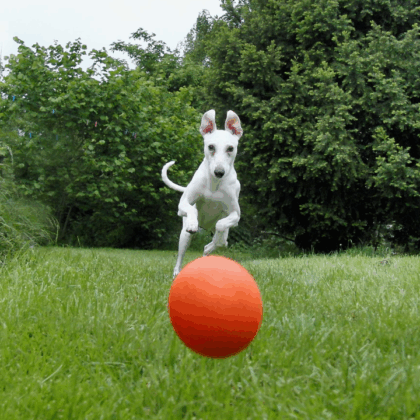The Power of DAN: How Dogs Maintain Focus When It Really Matters
Have you ever marveled at a Border Collie threading through an agility course at lightning speed, yet still responding to every subtle handler cue? Or watched a detection dog working methodically through an area filled with enticing scents, focused solely on finding their target odor?
These remarkable performances showcase the Dorsal Attention Network (DAN) at its finest—a neural system that, when properly engaged, enables dogs to perform impressive feats of focus and concentration.
What Is DAN and How Does It Work?
The Dorsal Attention Network (“top-down” attention) is your dog’s volitional attention system. Think of DAN as the executive assistant of your dog’s brain—it helps maintain focus on a chosen goal, filtering out distractions and keeping your dog’s attention where they’ve decided it belongs.
When DAN is in charge, dogs can ignore, put aside, or delay other behaviors that might interfere with achieving their goal. This is what allows that dog in the photo to focus completely on catching the ball, ignoring everything else in his environment.
The Three Critical Ingredients for Strong DAN
For DAN to function optimally in your dog, three essential conditions must be met:
- Intrinsic Motivation Must Be Present This is absolutely crucial. If the dog doesn’t genuinely care about the task at hand, DAN won’t engage fully. As I often explain, “If there isn’t any specific goal, then what’s going to happen is what’s salient to you is what’s going to drive the response.” This means that if you ask a dog to recall across a field, they might rocket to you, wanting to get to you and a reward. But they might start off towards you only to be distracted by a rabbit or an interesting scent that matters to them more than getting to you.
- The Dog Must Feel Safe Safety isn’t negotiable. When a dog feels threatened or anxious, their Ventral Attention Network (VAN) naturally takes precedence as a survival mechanism. For a fearful dog, many everyday stimuli can be worrisome. If the dog feels unsafe, that focused attention becomes impossible.
- Absence of Anxiety or Fear Closely related to safety, anxiety and fear flood the brain with stress hormones that directly interfere with DAN functioning. The prefrontal cortex—crucial for DAN—becomes less active under stress, while the amygdala—central to VAN—becomes more active. This is why anxious dogs often appear “distracted” or “stubborn” when they’re actually experiencing a neurobiological state incompatible with focused attention.
DAN in Action: Stories from the Field
Years ago, I knew a search-and-rescue dog who really did not deal well with other dogs, and often got himself into some brawls and noisy arguments. But when it came time to search, nothing interfered with this dog’s intrinsic motivation for finding his target other than the information that helped him do his job. Other dogs and significant environmental changes couldn’t override his focus. Once the search was over, well – back to being problematic!
DAN consumes conscious effort and concentration, so dogs (like us) can fatigue mentally. Be aware that patterned motor movements, such as doing weave poles, can be done almost on automatic pilot through habit and muscle memory.
Why Training Context Matters So Much
One of the most fascinating aspects of DAN is how it functions differently in what I call “cold cognition” versus “hot cognition” scenarios:
Cold Cognition: Low-pressure, non-emotional situations like practicing in your kitchen
Hot Cognition: High-pressure, emotionally charged situations involving social pressure, conflict, risk, or reward
The adolescent dog who performs brilliantly in your living room but falls apart at a competition isn’t necessarily insufficiently trained—their developing brain simply hasn’t mastered “hot cognition” scenarios where DAN must work harder to maintain control. This is a lot like a teenager can drive attentively and well with mom in the passenger seat, but makes very poor choices and drives dangerously in a car full of his friends.
This is why setting the expectation that a dog can make good decisions “at speed with arousal with a ton of external stimuli pulling on all those attentional factors is sometimes unfair, especially for young dogs. Build their skill in cold cognition settings first, working in hot cognition settings to help develop focus.
Building Stronger DAN Function
Understanding that DAN requires intrinsic motivation, safety, and emotional stability gives us a roadmap for strengthening it:
- Discover and harness what truly motivates your individual dog Instead of assuming all dogs want the same rewards, observe what genuinely excites your specific dog. For some, it’s a tennis ball; for others, it might be scent work or social interaction.
- Build a foundation of safety and trust Before expecting focused attention in challenging environments, ensure your dog views you as a reliable source of safety and information. This is where social referencing becomes crucial— your dog checks in with you to determine if something is safe or dangerous.
- Develop volitional attentional behaviors Rather than constantly cuing “watch me,” teach dogs the Auto Check-In, an RCT technique that teaches the dog to choose to check in. When the individual dog chooses to give you their attention, you really have the dog! Volunteered behavior is significantly stronger than when it’s prompted, in my experience.
- See the dog! As I emphasize, “If we say DOGS, we are talking about dogs in general, and the S stands for statistics. I want to work with the specific dog in front of you.”
- Progressive training in increasingly challenging environments Start in settings where your dog can easily maintain DAN dominance, then gradually introduce more challenging scenarios as their skills develop.
Remember that DAN requires energy and can be depleted. Just like you would be exhausted after doing complex math problems for hours, your dog’s ability to maintain focused attention will fatigue over time. Respect these limitations in your training plans.
The Takeaway: Respecting DAN’s Requirements
When we understand DAN’s power and its prerequisites, we can stop blaming our dogs for “blowing us off” and instead create conditions where their natural attentional abilities can flourish.
The next time you’re frustrated by your dog’s seeming inability to focus, ask yourself: Is this task intrinsically motivating for them? Do they feel completely safe? Are they free from anxiety and fear? If not, your training challenge isn’t about obedience—it’s about creating the conditions for DAN to thrive.
This post is based on concepts from Suzanne Clothier’s “Anatomy of Attention” webinar. You can enjoy that webinar, along with three others in Suzanne’s Summer School Series starting in July! This four webinar series will feature “Anatomy of Attention: When VAN ran over DAN and other Tales”, “Distractions and . . . SQUIRREL! Using them in Training”, “Training vs. Management” and “What’s the Problem?”, only available in the RCT Reference Collection or this series.
Summer presents unique challenges for dog training. The world explodes with distractions – squirrels dart across paths, children play in yards, and barbecue scents waft through the air. Rather than fighting an uphill battle, what if you could turn these summer challenges into training opportunities?
Suzanne Clothier’s Summer School Series brings together four essential webinars that will revolutionize how you approach training during these distraction-rich months.


